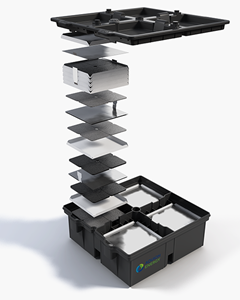Inside an Aquion AHI Battery
Aquion evokes two words, aqueous and ion—fittingly, since the Pennsylvania-based company, Aquion Energy, is known for Aqueous Hybrid Ion (AHI) battery systems. They are designed for long-duration cycling applications. Last month, they announced they were taking their AHI technology to a next level, providing energy gains without increasing the size or weight of their two product lines, the S-Line stack and the M-Line module. Translation: The Aquion's long-duration battery technology has got better. AHI batteries are now optimized for long charge and discharge cycles for solar and other renewable energy storage applications.
Their announcement is picking up lots of steam in media coverage. That attention is largely due to a key challenge in making renewable energy projects work—storing and transporting the power once the energy has been converted to electricity. Gigaom writer Katie Fehrenbacher recently commented how for the past several years batteries have taken center-stage in the solar industry. "When paired with solar panels, batteries can store solar energy at night when the sun goes down, making solar systems available to provide power around the clock. However, battery systems add significant costs to the solar system."
Enter Aquion. "A Battery to Prop Up Renewable Power Hits the Market" was the MIT Technology Review headline on Friday. Kevin Bullis said this new kind of battery was "the cheapest of a new generation of large, long-lived batteries that could make it possible to rely heavily on intermittent, renewable energy sources." Bullis further commented that their new energy storage technology could be crucial to making renewable energy more viable, especially in remote locations.
Discussing the advantages, the company said the new batteries are able to ease the burden of intermittent renewable energy on the grid. The batteries paired with a solar array will charge during sunlight hours, then provide consistent power overnight, will reduce intermittence throughout the day and relieve evening peak load. "Aquion batteries enable maximum utilization of renewable generation for self-consumption and reduce reliance on diesel."
At shorter four to eight hour discharge rates, systems will experience an energy increase of up to 40 percent.
At longer 20-hour discharge rates, the S-Line Battery Stack will see a 24 percent increase in energy to 2.4 kilowatt-hours.
At longer 20-hour discharge rates, the M-Line Battery Module will see a 16 percent increase, totaling 25.5 kilowatt-hours.
Grid-scale applications for Aquion's batteries would include peak shifting, load shaving, and renewables support.
They showed their technology at Solar Power International last month in Las Vegas. Their technology approach marks a departure from traditional battery chemistries repurposed for solar applications, such as lead acid and lithium ion.
The company was spun out of Carnegie Mellon in 2010. According to the company history, Jay Whitacre, founder and CTO, worked on the company's original technology, developing their saltwater batteries. The "saltwater electrolyte battery technology" uses nontoxic materials that are in abundance, they said, along with low-cost manufacturing techniques. AHI chemistry is composed of a saltwater electrolyte, manganese oxide cathode, carbon composite anode, and synthetic cotton separator. The battery uses noncorrosive reactions at anode and cathode to prevent deterioration of the materials. The water-based chemistry results in a nontoxic and noncombustible product. Applications would include off-grid and microgrids, energy management, and grid services.
Bullis also discussed the technology in MIT Technology Review: "Aquion's batteries use sodium ions from saltwater as their electrolyte. Electrical current moves through this brackish liquid from positive electrodes based on manganese oxide to negative ones based on carbon. The batteries are large and operate slowly, but they are also manufactured cheaply, using repurposed manufacturing equipment."
More information: www.aquionenergy.com
© 2014 Tech Xplore






















